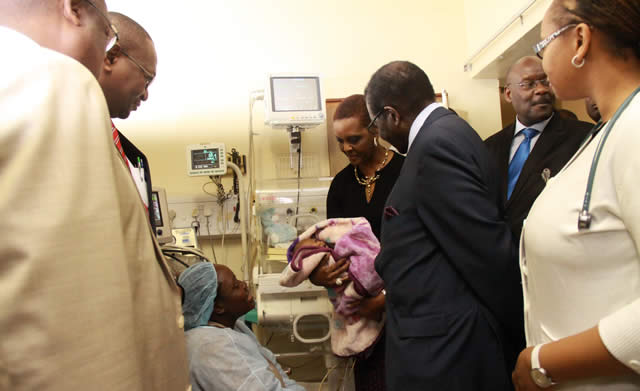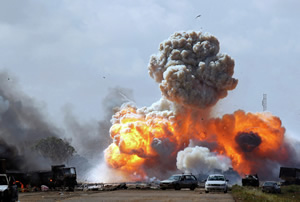Medical history as conjoined twins are separated


(File pic) President Mugabe and First Lady Amai Grace Mugabe have a look on one of the once cojoined twins seperated during an operation while the mother Agnes Chitiyo looks on with other officials.-(picture by Munyaradzi Chamalimba)
Paidamoyo Chipunza Senior Health Reporter
On July 29, 2014, a team of about 50 local health workers left an indelible mark in the history of the county’s medical sector since 1980 following the successful separation of two conjoined twins from Murehwa District in Mashonaland East province.
Born on April 22 2014 at Murehwa Rural District Hospital, the twin boys — Kupakwashe and Tapiwanashe — were joined from the lower chest to the upper abdomen and shared a liver.
Medical and non-medical personnel at the country’s sole children’s hospital, Harare Hospital, teamed up to separate the twins after their transfer from Murehwa.
“We needed everybody to be able to separate the babies properly. We also needed a lot of planning because it is not an everyday occurrence, there are very few incidences in the world where Siamese twins are separated,” said Dr Bothwell Mbuvayesango, leader of the team that operated on the boys.
“It was an all inclusive Zimbabwean team of doctors, nurses and support staff. We did not get any help from any other doctors from outside the country and the success is because we managed to plan and work together.”
Dr Mbuvayesango said the success of the operation was testimony to the fact that Zimbabwe has the expertise to do different major operations.
He said apart from the separation of the Murehwa Siamese twins, there were several other major operations conducted at Harare Central Hospital or at other public health institutions in the country not known to the general public.
“What these milestones mean is that we have the manpower who are enthusiastic, who are keen to work, who know what they are doing,” he said.
Dr Mbuvayesango said the country now needed to work on making these services affordable to the ordinary Zimba- bweans.
“Existing expertise coupled with affordability of the services, the country’s health sector is poised for greater heights,” said Dr Mbuvayesano.
He said there was also need for better organisation at all levels in the sector to make health services accessible and affordable for all.
Mr Moses Chitiyo, father to the children, said since the separation of his children, he now has confidence in an independent Zimbabwe to deliver reliable services to its citizens than before.
“Often, we would hear people talking of seeking health services outside the country for complicated procedures. That was my biggest headache as I knew I could not afford to have them separated outside the country,” said Mr Chitiyo.
The Murehwa Siamese operation was the first operation of its kind to be conducted in the country by a wholly local team. Previously major operations such as those for cleft lip and palate and hip replacements were conducted with assistance from foreign medical experts.
The only known local operation on Siamese twins was a “very minor” one successfully done at Harare Children’s Hospital a few years ago.
Zimbabwe has had five documented cases of co-joined twins since Independence and only one was referred outside the country, while in two instances the babies died before sur- gery.
In 2005, co-joined twins were successfully separated in Canada.
In 2009, a Tsholotsho woman gave birth to Siamese twins, but they died a few days after birth when Mpilo Hospital failed to secure enough human resources and funding to operate on them. Early last year, a woman from Kadoma gave birth to Siamese twins who died a few days after birth due to heart complications.
Towards the end of last year another couple from Karanda also gave birth to conjoined twins who are scheduled to be operated on at Harare Hospital soon.
Siamese twins are a result of either fission, in which the fertilised egg splits partially; or fusion, in which a fertilised egg completely separates but stem cells search for similar cells on the other embryo and fuse the twins.
So rare are conjoined twins that their occurrence is estimated to range from one in 50 000 births to one in 200 000 births in the world.
The overall survival rate for conjoined twins is approximately one in four.
They are known as “Siamese twins” after the famous pair of Chang and Eng Bunker from Siam, now Thailand.







Comments